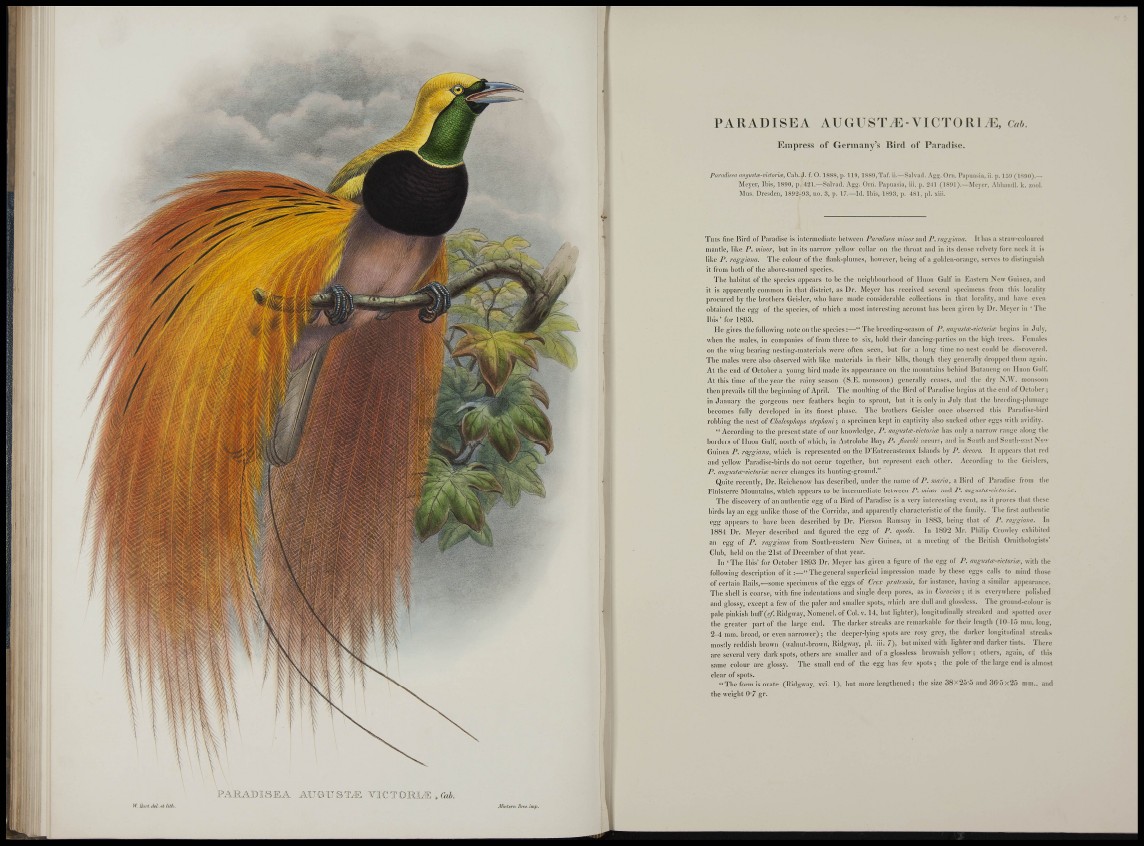
!! . ' l -
irr'
ii':
: 1 ( il
M
lii^PP
A R A D I S E A A U G U S T / E - \ Ca h .
Empress of Germany's Bird of Paradise.
Piiradisca aiic/iist£B-victùnce> Cab. J. f. O. 1888, p. 1 li), 1889, Tiif. ii.—Salvati. Agf^. Orii. Tapuasia, ii. p. l.'j!) (1 S!)(i).—
Meyer, Ibis, 1890, p. 421.—Salvaci. Agg. Oni. Pajmasia, iii. p. 211 (1 Bill).—Meyer, Aliliaiidl. k. z imi I .
Mus. Dresden, 1892-9;!, no. 3, p. 17.—III. Ibis, 1893, p. 4SI, pi. xiii.
Tiii.s fine Bird of Paradise is intermediate between Parmlisca ?H///o?'aiid J*, raggiana. It lias a slraw-cnlonred
mantle, like /'. minor, but in its narrow yellow collar on llie lliroat and in its dense velvety fore neck it is
like P. raggiana. The colonr of tlie llank-plnnies, liowever, being of a golilen-orange, serves to distingnisli
it from both of llie above-named species.
The hahitat of the species a])pears to be tlie neighbonrliood of llnon Gnlf in Kastern New Guinea, and
it is aj)parcntly common in that district, as Dr. IN'leyer has received several s])ecinicns from this locality
procured by the brothers Geisler, who have made considerable collections in that locality, and have even
obtained the egg of the species, of which a most interesting account has been given by Dr. Meyer in * 'i'he
Ibis' for 1893.
He gives the following note on the species :—" The breeding-season of P. (tugmtfai-vicloncc begins in Jidy,
when the males, in companies of from three to six, hold their dancing-parties on the high trees. Keniales
on the wing bearing nesting-materials were often seen, but for a long lime no nest could be discovered.
The males were also observed with like materials in their bills, though they generally dropped them again.
At the end of October a young bird made its appearance on the mountains behind liutaueng on lluon (inlf.
At this time of the year the rainy season (S.E. monsoonj generally ceases, and the dry N.W. monsoon
tlicn jirevails till the beginning of April. The moulting of the Bird of Paradise begins at the cad of October ;
in January the gorgeous new feathers begin to sprout, but it is only in July that the breeding-plumage
becomes fully developed in its finest phase. The brothers Geisler once observed this Paradise-bird
robbing the nest of Cimlcophaps stepjiani; a specimen kept in captivity also sucked other eggs with avidity.
"According to the present state of our knowledge, P. aiigiislfs-diclonat has only a narrow range along the
borders of Huon Gulf, north of which, in Astrolabe l?ay, P. Jimchi occurs, and in South and Soulli-east New
Guinea P. rt^giam, which is represented on the D'Entrecastcau.'i Islands by P. (kcom. It appears that red
and yellow Paradise-birds do not occur together, but re])rescnt cacli other. According to the (ieislers,
P. (mguslw-victoriic never changes its hunting-ground."
Quite recently. Dr. Reichenow has described, under the name of P. mark, a Bird of Paradise from the
Finistcrre Mountains, which appears to be intermediate between P. mimr and P. augusta-vkioria:.
The discovery of an authentic egg of a Bird of Paradise is a very interest ing event, as it proves that these
birds lay an egg nidike those of the Corvidffi, and apparently characteristic of the family. Tlie first authentic
egg appears to liave been described by Dr. Pierson liamsay in 1883, being that of P. raggmna. In
1884 Dr. Meyer described and figured the egg of P. tqmdn. In 1892 Mr. Phili|. Crowley e.xhibited
an egg of P. raggimm from South-eastern New Guinea, at a meeting of the liritish Ornithologists'
Club, held on the 21st of December of that year.
In 'The Ibis' for October 1893 Dr. Meyer has given a figure of the egg of P. augmlai-tktoriw, with the
following description of i t :—" The general superficial impression made by these eggs calls to mind those
of certain Uails,—some specimens of the eggs of Cre.v pratmsls, for instance, having a similar appearance.
The shell is coarse, with fine hidcntations and single deep pores, as in Coram«; it is everywhere polished
and glossy, e.xcept a few of the paler and smaller spots, which are dull and glossless. The ground-colour i.s
pale i)iiddsh buff(iy: Ridgway, Nomencl. of Col. v. M, but lighter), longitudinally streaked and spotted over
the greater part of the large end. The darker streaks are remarkable for their length (10-l.j mm. long,
2 - 4 mm. broad, or even narrower) ; the deeper-lying spots are rosy grey, the darker longitudinal strejiks
mostly reddish brown (walnut-brown, Ridgway, pi. iii. 7), hut mixed with lighter and darker tints. There
are several very dark spots, others are smaller and of a glossless brownish yellow; others, again, of this
same colour are glossy. The small end of the egg has few spots ; the pole of the large end is almost
clear of spots.
" The form is ovate (Ridgway, xvi. 1), but more lengthened ; the size 38x25-5 and 3(r.j x2.) mm., and
the weight O'Z gr.
j P A R A D I S J E i ^ AUGITSTJ E V l C T O R l . « ,
fiurl del H [Uh. Minterit Bnvi.uiip.